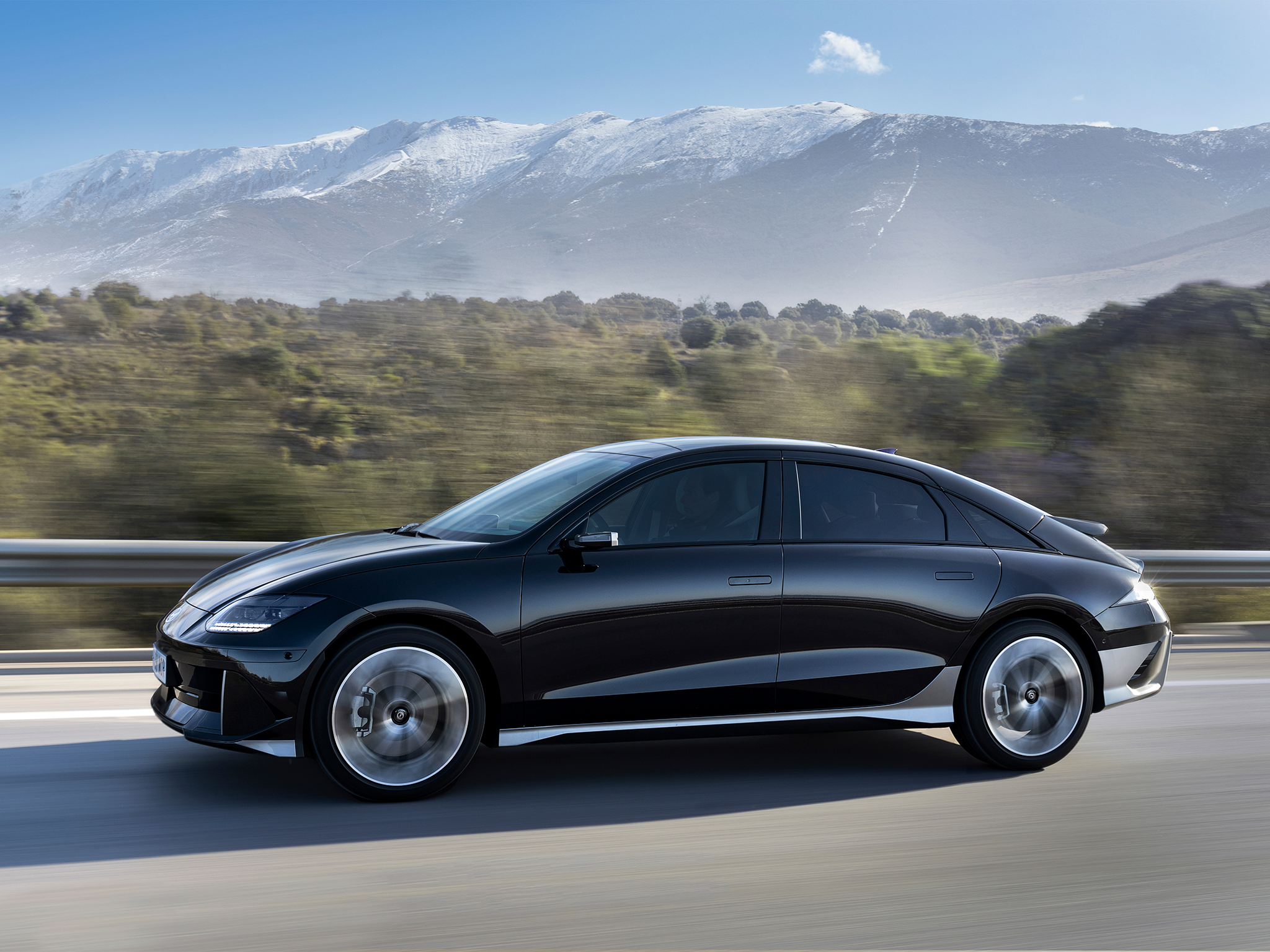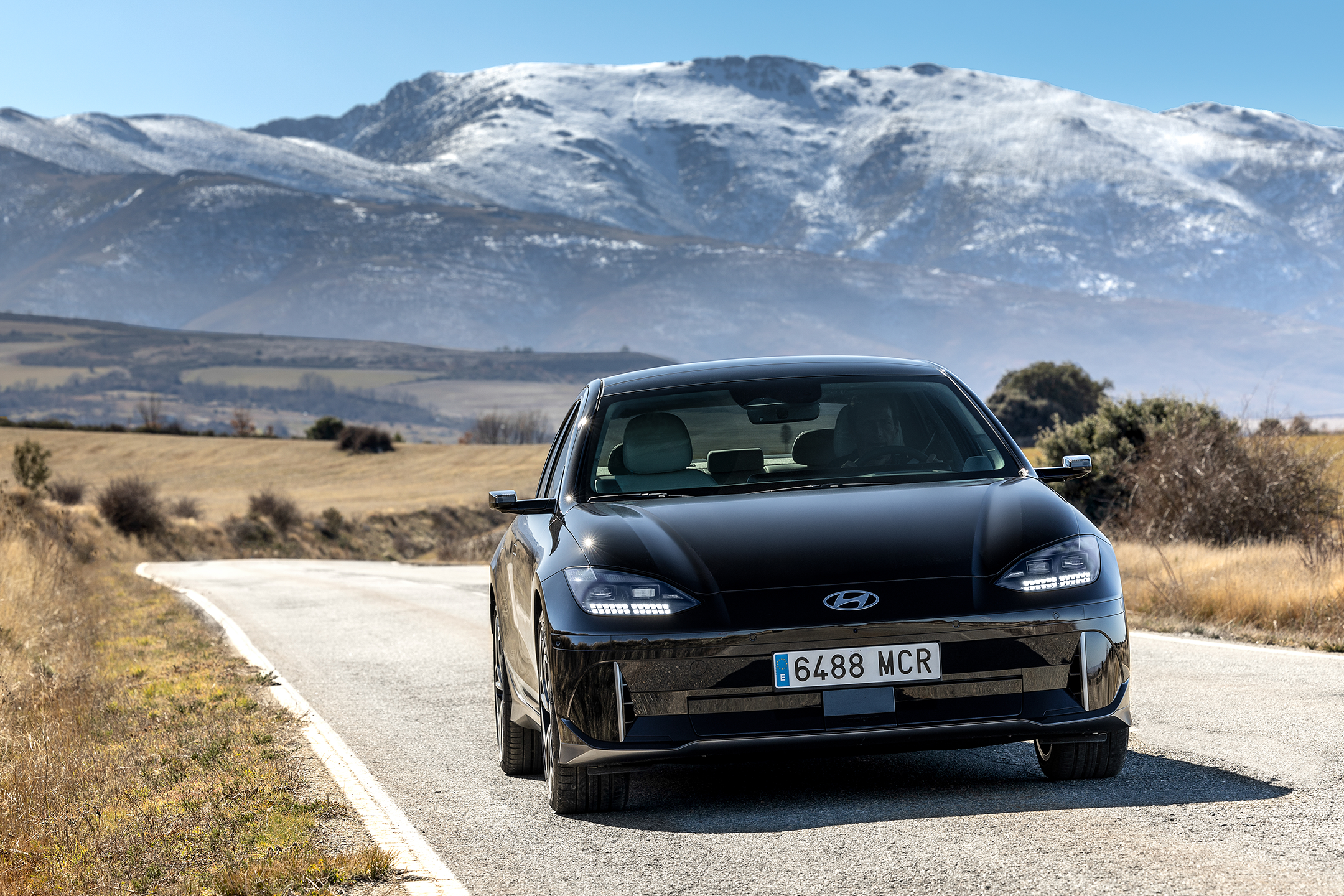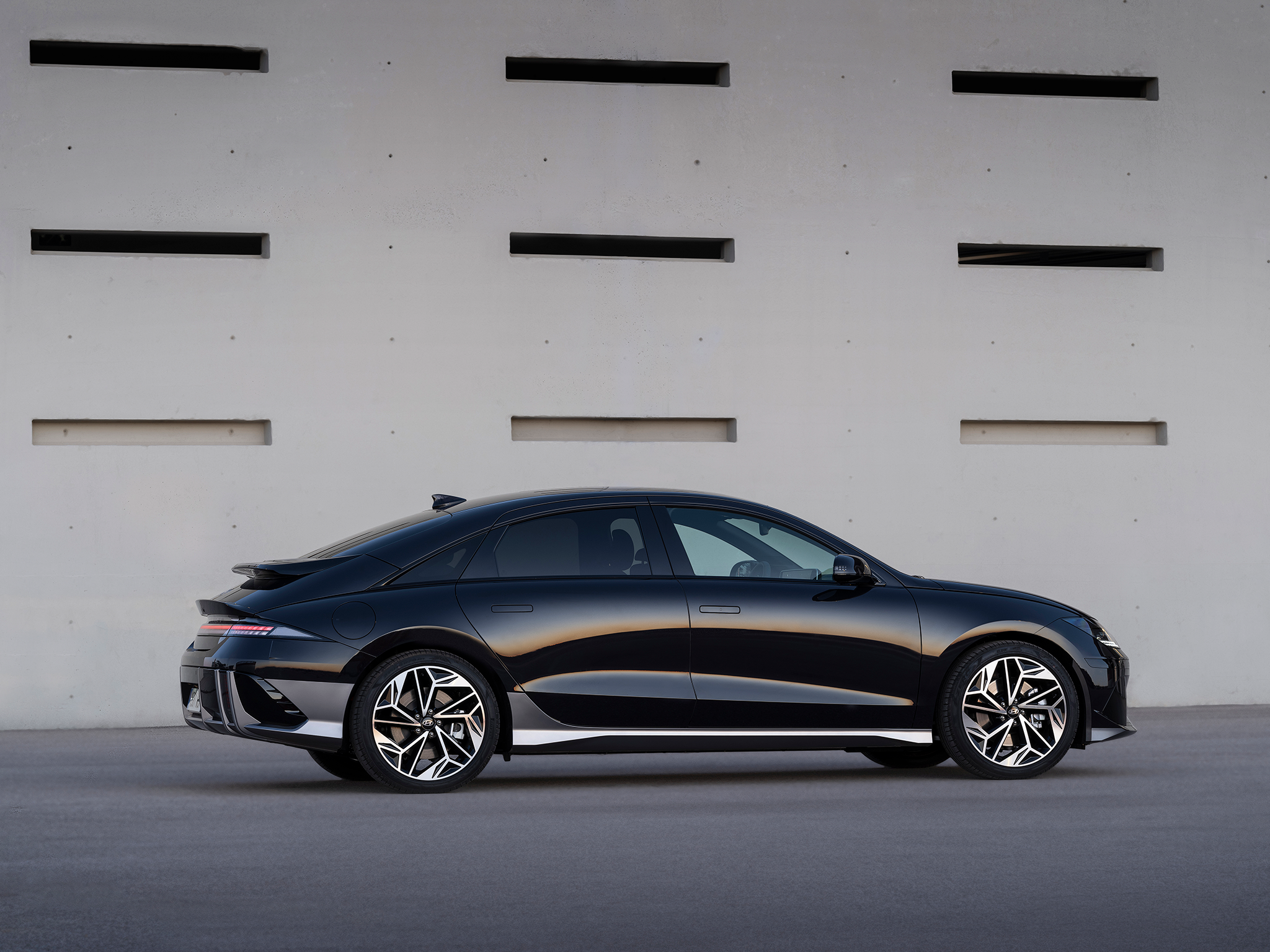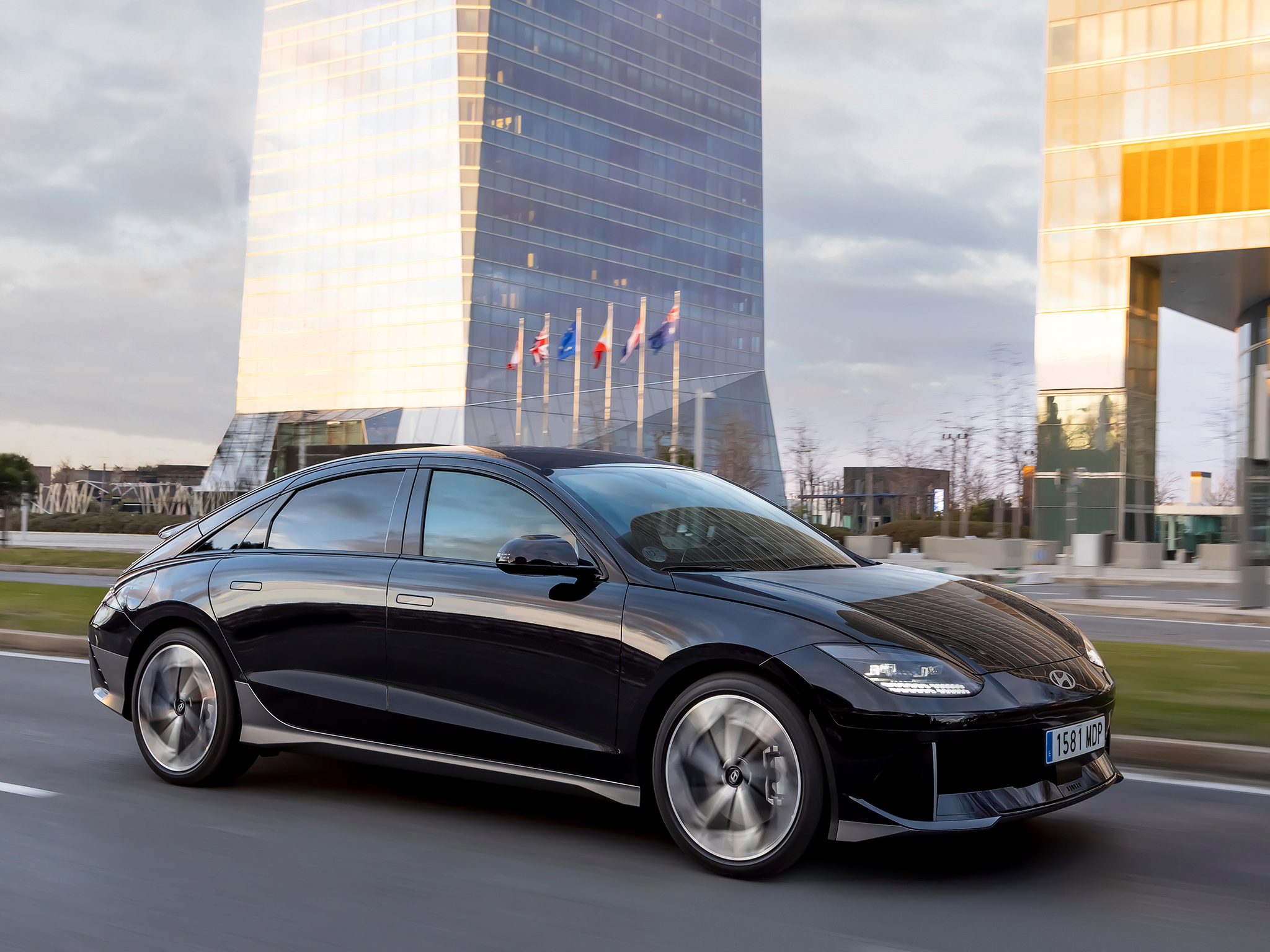Hyundai Ioniq 6 review: This EV offers rapid charging and a great range
Hyundai’s streamliner-style saloon is an EV that majors on efficiency and fast charging, but loses some practicality points as that dramatic, sloping roofline eats into cabin space.

The Independent's Electric Vehicles Channel is sponsored by E.ON Next.
Because electric motors take up less space than an engine – and because almost all electric cars sit on a so-called skateboard chassis, with a big battery in the floor and a motor at one or both ends – car designers have more freedom to experiment with the body and interior. And, since a slippery body means less drag and more range, the shift to EV has put a renewed focus on aerodynamics. The unusually designed Hyundai Ioniq 6 exemplified this more than most, with its streamliner-style body.
It also demonstrates how, no matter how the car looks, EVs often share their platforms with others. In this case, the Ioniq 6 uses the same E-GMP platform as the Kia EV6, the Genesis GV60 and the Hyundai Ioniq 5. All three brands are part of the same Korean company and these EVs all benefit from speedy charging; the Ioniq 6 can fill its battery at up to 233 kW, which is well above many other cars in its category.
The maximum range is stated as 338 miles, and if you plug into a 250 kW charger you should see the battery fill from 10 to 80 percent in under 20 minutes.
How we test
I spent an entire car with the car, driving on a wide variety of roads in and around the Oxfordshire countryside. This included town and city traffic, as well as flowing A-roads, dual-carriageways and lesser-used B-roads. I hooked up my phone and got to grips with the infotainment system before setting off.
Hyundai Ioniq 6: From £47,040, Hyundai.com

Independent rating: 7/10
- Pros: Striking design, strong range, fast charging
- Cons: Roofline robs headroom, climate touch controls can be tricky, lane-keep warnings can be tiresome
- Price range: £47,040 to £50,540
- Battery size: 77.4 kWh
- Range: 338 miles
- Miles per kWh: 3.9
- Maximum charge rate: 233 kW
- Charging cost per 100 miles on E.ON Next Drive: £1.50
Battery, range, charging and performance
Hyundai is using the shift to electrification as an opportunity to reinvent itself as an upmarket brand building stylish EVs with cutting-edge technology – and nowhere is this more obvious than with the Ioniq 6. A streamliner saloon that looks unlike anything else on the road, the Ioniq 6 shares the same EV platform as the Hyundai Ioniq 5, as well as the closely related Kia EV6 and Genesis GV60.
That platform houses a 77 kWh battery good for a claimed 338 miles and speedy 233 kW charging that’ll top the car up from 10 to 80 percent in as little as 18 minutes. There are two models on offer; one has a single motor, rear-wheel-drive and 225 bhp, and the other adds a second motor for all-wheel-drive and 321 bhp. As ever, the cheaper, slower (but still perfectly potent) car is the one to go for. It’ll sprint to 60 mph in 7.4 seconds, compared to 5.1s for the pricier dual-motor variant.
Interior, practicality and boot space
Hyundai likes to describe its Ioniq electric cars as being like chess pieces, each sitting a different body on a shared platform. While obvious outside, this philosophy extends, albeit to a lesser degree, to the interior too. Although great for aerodynamics, and therefore range, the sloping roofline robs the cabin of headroom compared to the taller Ioniq 5. Legroom is much better, in both the front and back, and there’s plenty of handy storage between the front seats
Wing cameras instead of mirrors are available as an option, but we prefer the car without. Standard-fit items include parking sensors and heated seats all round, as well as a heated steering wheel, ambient lighting, a heat pump and keyless entry. For an extra £3,000 the Ultimate trim includes a sunroof, ventilated seats and improved driver assistance tech.
Boot space is 401 litres for both variants, while the single-motor car has 45 litres under the bonnet compared to just 15 in the dual-motor car, owing to space occupied by the second motor.

Technology, stereo and infotainment
The dashboard houses a pair of 12.3in screens for the infotainment and driver display. The former is crisp and clear, with an intuitive and responsive user interface, plus physical buttons that serve as handy shortcuts to key functions like navigation and media. Wireless Apple CarPlay and Android Auto are both included, which you’re likely to use over the car’s own nav, and there’s wireless charging too.
A third display panel sits lower down on the dashboard. This houses physical buttons that are easy to press, alongside illuminated, touch-sensitive ones that can be trickier to operate with a glance. You’ll likely need to form some new muscle memory over a few drives of the car before you can confidently press them – and adjust the cabin temperature, for example – without taking your eyes off the road.
The aforementioned Ultimate trim level adds a head-up display that projects onto the windscreen, and an eight-speaker sound system from Bose.
Prices and running costs
The Ioniq 6 holds an £8,000 premium over the Ioniq 5, despite the traditional, taller shape of the latter earning it a more practical cabin with better headroom. The 5 also recently received a refresh with a larger 84 kWh battery, so now has more range, too. This puts the Ioniq 6 in a difficult position, as it becomes a car in need of admiration from your heart as well as your head.
Being an EV, running costs are generally much lower than those of an equivalent petrol car, and especially so if you charge from home and avoid spending too long plugged into expensive motorway chargers. Maintenance costs are also often reduced, thanks to the simplicity of electric drivetrains.

The Ioniq 5 and Ioniq 6 both share the same E-GMP platform. This means they use the same 800-volt electrical system, however the Ioniq 5 was recently updated and can charge slightly more quickly, at up to 350 kW compared to 270 kW for the Ioniq 6. The 5 also has a larger battery (84 kWh vs 77.4 kWh) and a longer range (up to 354 miles vs 338 miles).
How long does it take to charge?
The Ioniq 6 can charge at up to 270 kW, and if connected to a sufficiently powerful charge it can fill its battery from 10 to 80 percent in as little as 18 minutes. A full charge using a 7.4 kW home charger takes about 10.5 hours.
Does Hyundai replace batteries for free?
Hyundai provides a warranty for its EV batteries that lasts for eight years or 100,000 miles, whichever comes first.
The verdict: Hyundai Ioniq 6
The Hyundai Ioniq 6 is a car I want to love; spec the right colour and the exterior design is top-drawer, and it sits on one of the best EV platforms around, with rapid charging and a great range. But packaging compromises limit versatility and the Ioniq 5 is noticeably cheaper.
Hyundai’s quirky streamliner is as much a lesson in compromise and packaging as it is aerodynamics. Its designers should be admired for trying something new, and we totally get their chess-piece analogy. But taller drivers (and almost any rear-seat passengers) will struggle with a lack of headroom imposed by that dramatic roofline.
If you’re okay with that, then great; the Ioniq 6 sits on one of the best EV platforms there is. It charges quickly, has a great range of over 300 miles and is filled with tech. This is also another example of the less powerful, single-motor variant being the better option, while high-tech touches like wing cameras instead of mirrors are there for those who want full living-in-the-future vibes.
Join our commenting forum
Join thought-provoking conversations, follow other Independent readers and see their replies
Comments